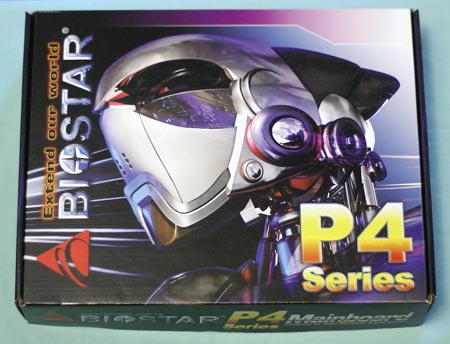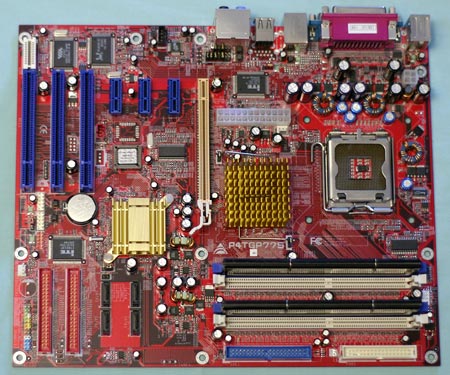915 Motherboard Roundup: Socket 775 for the Rest of Us
by Wesley Fink on December 7, 2004 12:25 AM EST- Posted in
- Motherboards
Biostar P4TGP 775: Features and Layout
| Biostar P4TGP 775 Motherboard Specifications | |
| CPU Interface | Socket 775 Pentium 4 (Prescott) |
| Chipset | Intel 915P/ICH6R |
| BUS Speeds | 200MHz to 255MHz (in 1MHz increments) |
| DDR2 Speeds | Auto, 333, 400 |
| PCI Speeds | 33.33, 36.36, 40.00 |
| Core Voltage | 1.25V to 1.60V in 0.0125V increments |
| DRAM Voltage | Default, 1.86V, 1.9V |
| NB (Northbridge) Voltage | Default, 1.86V, 1.9V |
| Memory Slots | Four 184-pin DDR 400 Slots Dual-Channel Unbuffered Memory to 4GB |
| Expansion Slots | 1 PCIe x16 Slot 3 PCIe x1 slot 3 PCI Slots SLR (Biostar Home Gateway) Slot |
| Onboard SATA/RAID | 4 SATA 150 drives by ICH6R Can be combined in RAID 0, 1, Intel Matrix |
| Onboard IDE/RAID | One Standard ATA100/66 (2 drives) plus 4 33/66/100 Drives by ITE8212 (RAID 0, 1, 0+1) |
| Onboard USB 2.0/IEEE-1394 | 8 USB 2.0 ports 2 IEEE 1394a FireWire Ports by VIA VT6307 |
| Onboard LAN | Gigabit PCI Ethernet by Realtek 8110S 4-port Router Card for SLR slot (Included) |
| Onboard Audio | CMI9880 (HD Audio) 8-Channel with Dolby Digital DDICE |
| Tested BIOS | 1.0 Award |
Over the years, Biostar has developed a reputation for delivering very solid boards at very attractive prices. The P4TGP 7875 is a good example of the value that Biostar delivers. Based on the 915P chipset, the Biostar still uses the preferred solution of the the ICH6R for the south bridge. This gives users the option of using the standout features of Intel Matrix RAID if they choose. Biostar also didn't compromise on audio, providing a High Definition audio solution that operates at 192kHz with 24bits, a greater than 95db Signal-to-Noise Ratio and Dolby Digital interactive Content Encoder (DDICE) compliance.

We appreciate the thinking that must have gone into these decisions and we think that Biostar made the right decision including these two trademark 915/925X features. Biostar also provides Gigabit LAN, but there is the compromise here in that the LAN resides on the PCI bus instead of the faster PCI Express. Biostar also provides Firewire ports and corrects the oversight of just 2 IDE devices with an added 4 IDE devices (total 6) with the ITE8212 controller. If you have been actually checking specs in the roundup, you will find that these features are missing from many boards which sell in the price range of the Biostar.
The Biostar also comes with a very interesting and unique feature called an RC8650 Router Card, which fits in a special SLR slot on the P4TGP 775. Most people these days have a router in their home system, and it is interesting to see Biostar including a router as part of their motherboard package. The WAN LAN connector plugs in the top port in the slot and there are 3 additional network connections available for more systems. An on-board router is an interesting idea to differentiate your motherboard design.

There is both good and bad in the Biostar P4TGP layout. Let's start with the good. The floppy and hard drive are in the preferred upper right edge location. This works best on most boards. The 4 SATA ports and 2 IDE connectors for 4 devices are also in reasonable locations at the lower right of the board. CD audio, if you need it, is around the midline of the board - in the PCIe slots area - which is OK. It would have been better above the slots. SPDIF in and out headers are in an unusual location between PCI2 x1 #3 and the first PCI slot. While the location looks a little strange, it works fine with accessory SPDIF brackets.
The most glaring fault in the Biostar layout, however, is a big one. The 24-pin ATX is in the middle of the board between the 915P north bridge and the rear IO. This is a horrible location that requires snaking the bulky 20/24-pin power cable around the CPU and hoping that it doesn't move and block air flow. The 12V 4-pin is better, near the top board edge, but the 20/24-pin really needs a new location on the Biostar board. Where other boards in the roundup seem to have some logic to their layout, the minor connectors on the Biostar seem to be sprinkled wherever there was room. The bulky cables except for power are OK, but things like the USB headers are in odd positions between slots.
We have complained in the past about boards where the memory slots are blocked by the video card. This is another board where you can't change memory without first removing the large video card. If you don't change memory very often, this will not be a problem, but if you frequently try out new memory, this tight fit will be a nuisance.
Overall, the decent layout of the rest of the bulky cables is marred by the horrible placement of the 20/24-pin power connector. Biostar would do themselves a favor by paying more attention to board layout in the future.
Asus P5GD2 Premium: Overclocking and Stress Testing
Biostar P4TGP 775: Overclocking and Stress Testing










26 Comments
View All Comments
coldpower27 - Tuesday, December 7, 2004 - link
Of course the Pentium 4 560 is gonna be outperformed, The Pentium 4 560 is designed to compete at the 417US price point while the Athlon FX 55 is designed for the 827US, were talking double the P4 560 in price. i believethe closest competitor for the Pentium 4 560 in price is probably the Athlon 64 3700+ even though it is on Single Channel DDR.danidentity - Tuesday, December 7, 2004 - link
Even the 3800+ could be included, but that is still about $180 more expensive than the 560, according to Newegg.danidentity - Tuesday, December 7, 2004 - link
I know comments like I'm about to make have been made before, and I am not biased, but I wanted to reiterate.Why is the FX-55 even part of the benchmarks in this review? Why not a 3500+? The FX-55 is TWICE the price of the Pentium 560 according to current Newegg prices.
I know the argument will be that the FX-55 and the 560 are two of the highest performing chips from the two camps. But the fact of the matter is that most people shopping for a 560 aren't going to be shopping for a FX-55. It's in an entirely different class.
mongoosesRawesome - Tuesday, December 7, 2004 - link
Can you do a comparison between soundstorm and dolby digital live? What is the bitrate of the encoding? Frequency range? Overall quality?It seems like this may be the second time I pass on AC3 encoding though. Last time I chose a northwood platform over AMD and NF2, and this time I'll likely choose the NF4 over intel and dolby digital live.
Would be nice to be able to easily hook it up to my klipsch dolby digital decodor though...
anandtechrocks - Tuesday, December 7, 2004 - link
Thanks for the great review!MAME - Tuesday, December 7, 2004 - link
AMD >>>>>>>>>>>>> *